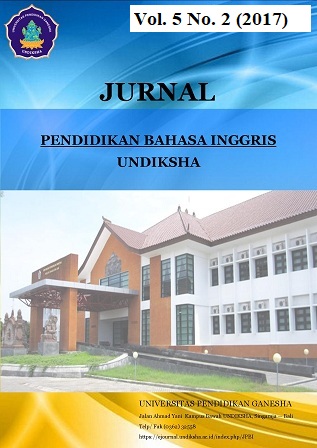The Research and Development of Bilingual Picture Storybook for Children
DOI:
https://doi.org/10.23887/jpbi.v5i2.11516Abstract
Penelitian ini bertujuan untuk mengembangkan buku cerita bergambar. Dalam penelitian ini, buku cerita bergambar di kembangkan menggunakan metode R&D Lee dan Owen, yang menggunakan 5 langkah sebagai berikut; 1) analisi, 2) desain, 3) pengembangan, 4) implementasi, dan 5) evaluasi. Metode ini digunakan karena sangat udah dimengerti. Selama proses pengembangan, data di kumpulkan dari kuesioner dan wawancara dengan 20 murid dan seorang guru bahasa inggris yang berpartisipasi. Hasilnya, 16 dari 20 siswa menunjukan ketertarikan terhadap buku cerita dwi-bahasa dari pada buku cerita bergambar bahasa inggris. Sedangkan untuk hasil wawancara, guru setuju bahwa buku cerita bergambar memiliki potensi sebagai media belajar yang bisa meningkatkan minat membaca dan belajar bahasa inggris. Buku cerita bergambar lalu di desain secara digital menggunakan aplikasi mendesain dan menggambar PaintToolSAI, karena sangat mudah di operasikan. Lalu, buku yang selesai di evaluasi oleh dua penilai; dosen bahasa inggris dari Universitas Pendidikan Ganesha dan guru bahasa inggris dari salah satu sekolah dasar di Singaraja. Mereka dipilih sebagai penilai karena kedua penilai adalah ahli dalam pengajaran bahasa inggris. Selama penilaian, lima kriteria diberikan; 1) sangat bagus (x̅ ≥ 4.05), 2) bagus (3.35 ≤ x̅ < 4.05), 3) rata-rata (2.67 ≤ x̅ < 3.35), 4) dibawah rata-rata (1.95 ≤ x̅ < 2.67), and 5) kurang (x̅ < 1.95). Karena skor rata-rata kedua penilai adalah 4.33, maka buku cerita bergambar yang di kembangkan adalah produk yang sangat bagus. Disamping penilaian tersebut, perbaikan masih dibutuhkan untuk menyempurnakan buku cerita yang telah dikembangkan.Kata Kunci : Buku cerita dwi-bahasa, Buku cerita bergambar
This research aimed at developing picture storybook. In this research, picture storybook is developed using Lee and Owen’s R&D method, which uses 5 steps as follow; 1) analysis, 2) design) 3) development) 4) implementation, and 5) evaluation. This method is used since it is easier to understand. During the development process, data gathered from questionaires and interview with 20 students and 1 english teacher were participated. Result was, 16 students out of 20 showed interest on bilingual picture storybook than the English one. For the interview result, teacher aggreed that picture storybook had potential to be used as learning media which was able to increase the students’ interest in reading and learning English. The picture storybook then designed digitally using digital drawing and designing applications PaintToolSAI, since it is easier to operate. Then, the finished book evaluated by two assessors; an English lecturer of Ganesha University of Education and an English teacher of an elementary school in Singaraja. They were selected as the assessors for the picture storybook since both assessors are experts in English teaching. During the assessment, five criterias were given; 1) excellent (x̅ ≥ 4.05), 2) good (3.35 ≤ x̅ < 4.05), 3) average (2.67 ≤ x̅ < 3.35), 4) below average (1.95 ≤ x̅ < 2.67), and 5) poor (x̅ < 1.95). Since both assessors’s mean score was 4.33, the developed picture storybook is categorized as excellent product. Despite this scores, revisions are still needed to perfect the developed picture storybook.
keyword : Bilingual storybook, Picture storybook
Published
2017-07-27
Issue
Section
Articles
License
Authors who publish with the Jurnal Pendidikan Bahasa Inggris Undiksha agree to the following terms:- Authors retain copyright and grant the journal the right of first publication with the work simultaneously licensed under a Creative Commons Attribution License (CC BY-SA 4.0) that allows others to share the work with an acknowledgment of the work's authorship and initial publication in this journal
- Authors are able to enter into separate, additional contractual arrangements for the non-exclusive distribution of the journal's published version of the work (e.g., post it to an institutional repository or publish it in a book), with an acknowledgment of its initial publication in this journal.
- Authors are permitted and encouraged to post their work online (e.g., in institutional repositories or on their website) prior to and during the submission process, as it can lead to productive exchanges, as well as earlier and greater citation of published work. (See The Effect of Open Access)













